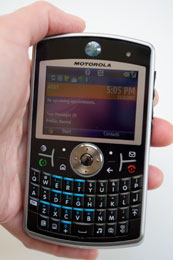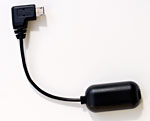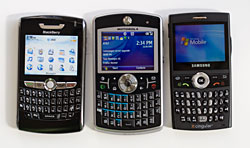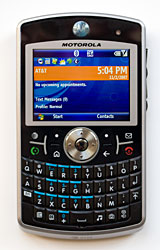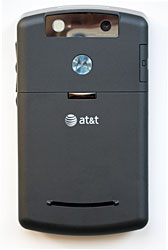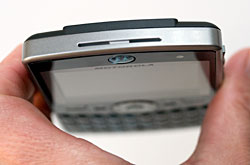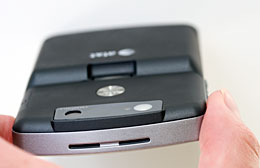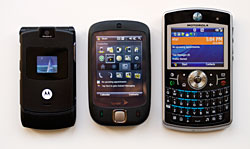
|
||||||||||||||||
Fast data in the form of HSDPA means fast web browsing and email downloads. The Q has a dual band 850/1900MHz 3.5G radio that supports both US bands used by AT&T, but not overseas bands. Connections were fast, reliable and we found it a pleasure to browse the web using Opera and IE. For those who wish to tether and use the Q9h as a wireless modem for a notebook, the phone supports DUN and we got a fast connection averaging 900kbps in our strong HSDPA coverage area. Setting up the connection with a Fujitsu U810 Windows Vista "micro notebook" was simple enough, and you need not enable DUN (dial up networking) on the phone, simply discover the phone using a PC, pair and the PC should find the DUN service. We did have to use a fairly common initialization string in the wireless modem settings under Windows Vista (Toshiba Bluetooth stack) to get things working: +CGDCONT=1,"IP","WAP.CINGULAR" (if you have a PDA data plan rather than a MediaNet data plan use ISP.CINGULAR instead of WAP.CINGULAR).
Motorola took a different route in their software bundle. They include the full smartphone version of Opera (not the free Opera Mini) which costs $24 if purchased separately. HTC went this route with the high-end Advantage, but so far every other Windows Mobile phone comes only with the default IE. Opera is very capable, supports multiple windows, Javascript, dHTML and in general whips the pants off of IE Mobile. IE Mobile is on the phone as well, should you prefer it for some reason. Mail, SMS and MMS are handled by the usual Windows Mobile Messaging application, which does a good job of POP, IMAP, Exchange and MS Direct Push email. There's a link to get Good's messaging client, the usual XPress Mail and AT&T says that BlackBerry Connect for the Q will come in Q1 2008. ThumbSpeed's IM client is on board and it handles Windows Live Messenger, AIM and Yahoo instant messaging. IM can run in the background and notify you of new messages and automatically run and log you in at startup (if desired). Horsepower, Performance and Multimedia The Q9h is smarter than the average Windows Mobile smartphone thanks to its 325MHz Texas Instruments OMAP 2420 CPU (most WinMo smartphones have a 200MHz processor). It also ups the ante on memory with 256 megs of flash memory rather than the usual 128 megs and 96 megs of RAM (used like RAM in your computer) rather than the standard 64. This means the Q9 Global is less sluggish than the T-Mobile Dash and Cingular 3125 for example, and the phone won't run out of memory when several applications are running. This is commonly a concern on WinMo phones because they are multitasking and most apps have only a minimize function rather than exit, so once you start them up, they keep on running unless you resort to Task Manager to manually kill them. 96 megs of RAM with 66 megs free at boot means never having to say you're sorry for running several apps at once. With 135 megs of flash memory available for storage, you can install plenty of 3rd party apps, email attachments and documents on the phone. For your music and perhaps even video collection, get a microSD memory card. The Q Global can handle cards up to 32 gigs capacity (there are none on the market yet though, 8 gigs is the biggest as of 11/2007). Still, 4, 6 or 8 gigs puts you in iPod nano territory and unlike an iPod, the phone can play music wirelessly to Bluetooth headphones and stereo headsets. Unfortunately, Windows Media Player Mobile isn't nearly as nifty and capable as a dedicated MP3 player in terms of features. Why must we manually tell the program to look at the storage card instead of internal memory for example, when most phones do this automatically? You can however sync playlists from Windows Media Player 10 on the desktop to the phone, copy tracks using Media Player or just drag them to a card using a card reader on your computer, and get basic track info such as artist name, album and length. Moto and AT&T include an adapter for 3.5mm standard stereo headphones and the audio quality is indeed excellent. Likewise, when we tested the phone with the Motorola S9 stereo headset and the Plantronics Pulsar 590, sound quality was very good. We heard less hiss than usual from the S9 and got good bass and great range with the Pulsar.
The Q's bright and sharp landscape QVGA 320 x 240 display makes it an excellent vehicle for video playback. AT&T's CV (now called Cellular Video, formerly called Cingular Video) works well on the smartphone, bringing you free content from CNN, ESPN, Disney, The Weather Channel, Fox news, MTV and more as well as subscription content such as HBO mobile (full episodes of some HBO shows). Playback is handled by Windows Media Player Mobile and the transition is smooth going between the browser and the player. CV video quality is excellent-- sharper than Verizon and Sprint's streaming services, though the video fills only a portion of the screen. Pocket PC phones (aka Windows Mobile 6 Professional) are generally better suited to video playback of burned media from DVDs and the like thanks to their generally faster CPUs and some even have graphics chips. The Moto does better than average among smartphones though; we usually find anything encoded above 300kbps doesn't play well, while the Q9h managed to play WMVs encoded at 500kbps. AT&T bundles their music mall (links to buy music online from various partners), and MusicID which can identify songs played back in range of the phone's mic (this is a pay-for service however). There's also XM Radio Mobile for those with an account and a link to get MobiTV (also requires a monthly fee). GPS The Moto has an internal GPS, though we doubt it's a SiRF III. It was slower to pick up satellites on a cold start (first time using GPS after booting up) than the Tilt, and took about 45 seconds to a minute. Thereafter it hung onto 3 satellites indoors near an exterior wall and behaved well in the car. When using the included TeleNav GPS Navigator, it sometimes complained that the GPS signal was weak, but it never lost the signal nor did it get us lost. TeleNav is an excellent subscription-based mapping and navigation package that does some of the best routing and prompting in the business. It has a very good POI database, up-to-date maps and traffic checking with re-routing. The only thing it doesn't do is contacts integration. The Q9 Global has a link to download TeleNav and there's a free trial, after which you'll have to pay $9.99/month for unlimited routes or you can buy a pack of 10 routes for $5.99 if you don't need the GPS frequently. For those who prefer the free route, Google Maps smartphone edition works fine with the GPS-- just select Track Location in Google Maps to turn on the GPS and find yourself in the world. Windows Live Search works well with the GPS as well, and offers some cool extra features like finding gas stations or movies playing nearby (movie theatres can even be called directly from with Live Search). Software We don't usually dedicate a section of our Windows Mobile phone reviews to software because there's very little variation from the basic Microsoft standard issue applications. Motorola has taken a different route and we applaud them. As mentioned earlier, Moto adds the capable Opera web browser, and they also include Documents To Go rather than Microsoft's basic mobile Office suite. Docs To Go is more capable and can create, read and edit Word and Excel documents and view PowerPoint presentations. It also includes a PDF reader and a zip manager. Personalize My Q is a handy app that lets you customize various aspects of the home screen including right soft key shortcut and on-screen shortcuts to applications.
Battery Life We always worry when a standard and extended battery come in the box. Yes, it's great to have them, but it sometimes indicates that battery life isn't very good. Like the Samsung BlackJack which also comes with 2 batteries, and like the original Q, battery life isn't this smartphone's strong point. However, it is better than the original Q and it's as good as the BlackJack's, if not a bit better. Our BlackJack required charging every other day with light use and the Q9 Global manages 3 days with the standard 1100 mAh Lithium Ion battery. The AT&T Tilt required charging every 1.5 days for comparison and the Cingular 3125 lasted 3-4 days, but it's not 3G so we expect better battery life. The extended battery increases battery runtimes by about 70% as we'd expect from the 700 mAh of additional juice. The 1800 mAh battery is the one to take on a business trip when you won't be near an AC outlet for a 12 hour day if you use the phone heavily and turn on MS Direct Push email. We got 3-4 day on a charge with the extended battery with light use and over 2 with moderate to heavy use (Direct Push turned on, talking on the phone 1 hour/day, surfing the web over HSDPA for 45 minutes/day and watching CV for 40 minutes/day). Conclusion We like it, yes we do. The phone is smart looking, slim and packs quite a bit of power. The ample memory, faster than average CPU and great software bundle put the Motorola Q Global ahead of the pack, and the GPS competes with the BlackBerry 8800 and 8820. The keyboard is one of the best we've used, the camera is decent and HSDPA performance as well as call quality are excellent. We like that the extended battery is included in the box, and we're not too down on the Q9's battery life overall. We do wish the GPS was quicker to pick up satellites but once it's locked on, it did work well for us. Pro: Slim, great keyboard, plenty of flash storage and RAM, supports SDHC microSD cards (large capacity cards), fast HSPDA, has GPS that works with both the bundled TeleNav and 3rd party navigation and mapping applications, excellent software bundle. Plays CV for downtime amusement and supports XM Satellite radio. Good voice dialing and mapped keyboard keys speed up access to commonly used applications. Customizable home screen means you can put your favorites apps there for fast access. Con: GPS is slow to get a first fix and TeleNav complains about signal strength under open skies, though this hasn't effected GPS performance so far. We wish there were a way to remove the XPress Mail item from the home screen without using a registry editor or switching to a more basic Today Screen.
Price: $199 with 2 year contract after rebate Web sites: www.hellomoto.com, wireless.att.com
| ||||||||||||||||
